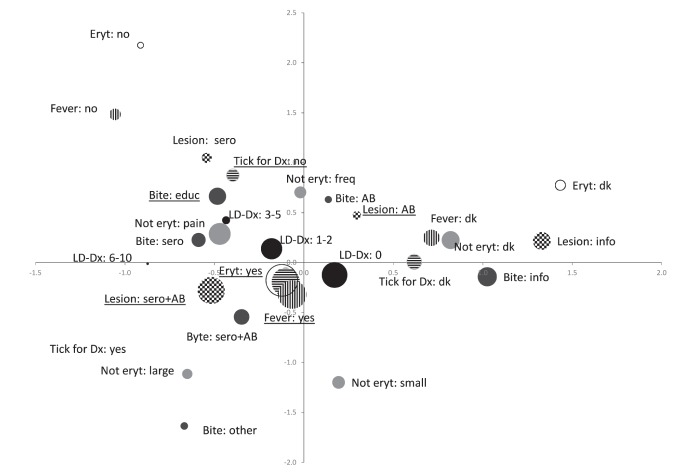Figure 3).
Map resulting from the multiple correspondence analysis of 151 general practitioners’ answers to six questions. The bubbles represent the relative location of each possible answer given for every question on the two-dimensional plan that shows most of the variability in the answers. The size of the bubbles is proportional to the number of respondents for the variable it represents. The questions were the following. 1) ‘When faced with a patient with a known tick bite but no symptoms and normal findings on examination, what do you do or what would you do?’ (dark gray bubble). The choices were ‘serology for Lyme disease’ (Bite: sero), ‘antibiotic treatment for Lyme disease’ (Bite: AB), ‘serology and antibiotic treatment for Lyme disease’ (Bite: sero+AB), ‘no serology, no antibiotics, educate patient, follow up as needed’ (Bite: educ), ‘I need more information to manage this patient’ (Bite: info), ‘other action or treatment’ (Bite: other). 2) ‘When faced with a patient with erythema migrans (erythematous skin lesion typical of Lyme disease), what do you do or what would you do?’ (checked bubble). The choices were ‘serology for Lyme disease’ (Lesion: sero), ‘antibiotic treatment for Lyme disease’ (Lesion: AB), ‘serology and antibiotic treatment for Lyme disease’ (Lesion: sero+AB), ‘no serology, no antibiotics, educate patient, follow up as needed’ (Lesion: educ), ‘I need more information to manage this patient’ (Lesion: info), ‘other action or treatment’ (Lesion: other). 3) ‘A patient brings you a tick that bit him/her. You send the tick to the laboratory for identification and to test for B burgdorferi. According to you, are the lab results useful for the diagnosis of Lyme disease?’ (horizontally striped bubble). Answer choices were ‘yes’ (Tick for Dx: yes), ‘no’ (Tick for Dx: no), and ‘don’t know’ (Tick for Dx: dk). 4) ‘What is the only characteristic that does not comply with the classical definition of erythema migrans?’ (light gray bubble). The choices were ‘bull’s-eye lesion’ (Not eryt: small), ‘expanding lesion larger than or equal to 5 cm’ (Not eryt: large), ‘lesion occurs in 60% to 80% of cases’ (Not eryt: freq), ‘painful lesion’ (Not eryt: pain), ‘don’t know’ (Not eryt: dk). 5) ‘In the case of fever, do you think the patient is in an acute phase of Lyme disease?’ (vertically striped bubble). The choices were ‘yes’ (Fever: yes), ‘no’ (Fever: no), or ‘don’t know’ (Fever: dk). 6) In a case of erythema migrans, do you think the patient is in an acute phase of Lyme disease?’ (white bubble). Choices were ‘yes’ (Eryt: yes), ‘no’ (Eryt: no), or ‘don’t know’ (Eryt: dk). Correct answers to the six questions are underlined on the map. Finally, the dark bubbles show the number of patients for whom the physician thought Lyme disease was a potential diagnosis during the year 2011 (LM-Dx: 0 patients, LM-Dx: 1–2 patients, LM-Dx: 3–5 patients and LM-Dx: 6–10 patients). See the figure highlights in the text.

